5 Best laptop for computer engineering 2024
Are you a computer engineering student struggling to find the perfect laptop for your studies? Look no further! In this blog post, we will dive into the world of laptops specifically tailored for computer engineering. Say goodbye to the confusion and endless research, as we unveil the best options that will meet your requirements without breaking the bank.
Best laptop for computer engineering
| Serial No. | Product Name | Check Price |
| 1 | Dell XPS 15 | Check Price |
| 2 | Lenovo ThinkPad P52 | Check Price |
| 3 | ASUS ROG Zephyrus G14 | Check Price |
| 4 | HP Spectre x360 | Check Price |
| 5 | Apple MacBook Pro | Check Price |
1. Dell XPS 15
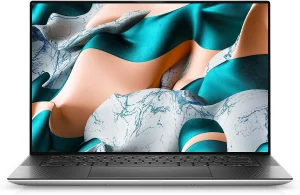
| Specification | Description |
| Touchpad Size | 62% larger |
| Screen Size | 5% larger |
| Footprint | 5.6% smaller |
| Display | 16:10 FHD+ edge-to-edge |
| Display Features | DisplayHDR 400, Dolby Vision |
| Eyesafe Display Technology | Integrated |
| Speaker Design | Quad speakers with Waves Nx audio |
| Sidewalls | High-polished diamond-cut |
As a computer engineering enthusiast, I’ve spent countless hours searching for the ultimate laptop that can keep up with my demanding tasks. And let me tell you, the Dell XPS 15 is a game-changer in every aspect.
Starting with its sleek design, the XPS 15 boasts a 62% larger touchpad, making navigation a breeze. The 5% larger screen offers a stunning 16:10 FHD+ display, complete with DisplayHDR 400 and Dolby Vision technology. Whether you’re coding, designing, or analyzing data, the visuals are crisp, vibrant, and truly immersive.
One standout feature is the integrated Eyesafe display technology, which reduces harmful blue light emissions without compromising color accuracy. This means I can work for hours without straining my eyes, making those late-night study sessions a lot more comfortable.
But it’s not all about visuals; the XPS 15 delivers an exceptional audio experience too. With its quad-speaker design and Waves Nx audio, every sound is rich, clear, and immersive. Whether I’m watching tutorials or enjoying some music during breaks, the audio quality never fails to impress.
Lastly, the high-polished diamond-cut sidewalls give the XPS 15 a premium feel and durability that sets it apart from the competition.
Pros:
- Impressive touchpad size for easy navigation
- Stunning display with HDR and Dolby Vision
- Eyesafe display technology for reduced eye strain
- Immersive audio experience with quad speakers
- Premium build quality with diamond-cut sidewalls
Cons:
- A slightly smaller footprint may take some getting used to
- Limited availability of ports
2. Lenovo ThinkPad P52
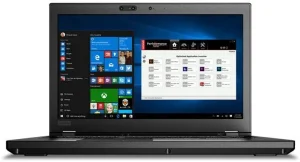
| Specification | Description |
| Warranty | 18 Months |
| Storage | 512 GB SSD |
| RAM | 32 GB |
| Processor | Intel Core i7 2.60 GHz |
When it comes to tackling complex computer engineering tasks, the Lenovo ThinkPad P52 has proven to be my ultimate companion. With its robust specifications and reliable performance, this laptop is truly a force to be reckoned with.
First and foremost, the ThinkPad P52 comes with an impressive 18-month warranty, providing peace of mind and ensuring that I can focus on my work without worrying about potential issues. It’s good to know that Lenovo stands behind the durability and quality of their product.
With a spacious 512 GB SSD, I can store all my important files, software, and projects without worrying about running out of space. The lightning-fast Intel Core i7 2.60 GHz processor ensures that my tasks are executed swiftly and efficiently, even when dealing with resource-intensive applications.
Multitasking is a breeze thanks to the generous 32 GB of RAM. I can seamlessly switch between multiple programs and run virtual machines without experiencing any lag or slowdowns. It’s an absolute game-changer for computer engineering professionals like myself.
The ThinkPad P52’s sturdy build quality and reliable performance make it ideal for demanding tasks. The keyboard is comfortable and responsive, allowing for long coding sessions without any discomfort. The vibrant display and accurate color reproduction enhance my visual experience, whether I’m designing schematics or analyzing data.
Pros:
- Generous warranty period for added peace of mind
- Ample storage capacity to accommodate large projects
- Powerful processor for fast and efficient performance
- Impressive RAM capacity for seamless multitasking
Cons:
- Slightly heavier compared to other laptops in its category
- Battery life could be improved for longer work sessions on the go
3. ASUS ROG Zephyrus G14
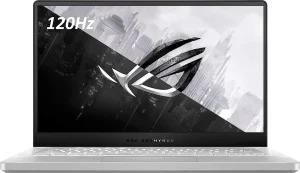
| Specification | Description |
| Display | 14in Full HD, 1920 x 1080, 120Hz refresh rate |
| Processor | AMD Ryzen 9 4900HS, 8 Core, up to 4.30GHz |
| Storage | 1TB SSD |
| RAM | 16GB DDR4 |
| Graphics | NVIDIA GeForce RTX 2060 Max-Q, 6GB GDDR6 |
| Connectivity | WiFi 6 – 802.11 ax |
| Keyboard | Chiclet keyboard with white backlight |
| Weight | 3.64 lbs |
| Operating System | Windows 10 Home |
The ASUS ROG Zephyrus G14 is a true game-changer in the realm of computer engineering laptops. Combining power, portability, and innovative features, this laptop has redefined what it means to be the best in its class.
The 14-inch Full HD display with a refresh rate of 120Hz provides a visually stunning experience. Whether I’m coding, designing, or analyzing complex data, the vibrant colors and sharp details make every task a pleasure.
The AMD Ryzen 9 4900HS processor, with its impressive 8 cores and clock speed of up to 4.30GHz, ensures that I can breeze through demanding engineering tasks without any hiccups.
Storage is never a concern with the generous 1TB SSD, allowing me to store all my projects, software, and files with ease. The 16GB DDR4 RAM ensures smooth multitasking, allowing me to run resource-intensive applications simultaneously without any noticeable lag.
The NVIDIA GeForce RTX 2060 Max-Q graphics card with 6GB GDDR6 dedicated video memory takes the laptop’s performance to the next level. It’s virtual reality ready, making it a perfect companion for computer engineering professionals who delve into immersive simulations.
The ASUS ROG Zephyrus G14 is not only powerful but also delivers an exceptional audio experience. The speakers with Smart AMP Technology and Dolby Atmos produce incredible sound quality, immersing me in the audio details of my projects.
Pros:
- Impressive display with a high refresh rate for an immersive visual experience
- Powerful processor capable of handling demanding tasks
- Ample storage and RAM for seamless multitasking
- Dedicated graphics card for enhanced performance
- Superb audio quality with Dolby Atmos
Cons:
- Limited connectivity options, lacking certain ports
- Keyboard backlighting could be more customizable
4. HP Spectre x360
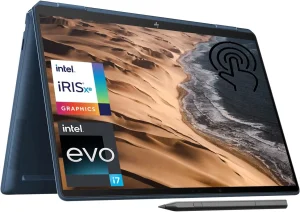
| Specification | Description |
| RAM | 16GB |
| Storage | 512GB PCIe NVME M.2 SSD |
| Processor | Intel Evo platform 12th Gen Core i7-12700H |
| Graphics | Intel Iris Xe Graphics |
| Display | 16-inch diagonal, 3K+, multitouch-enabled |
| Connectivity | Thunderbolt 4, USB Type-A, HDMI 2.1, Wi-Fi 6E |
| Keyboard | Backlit Keyboard |
| Operating System | Windows 11 Home |
The HP Spectre x360 is a laptop that seamlessly combines power, elegance, and versatility, making it the perfect choice for computer engineering professionals like myself. With its impressive specifications and sleek design, it truly stands out as one of the best laptops in its class.
The 16GB of high-bandwidth RAM ensures that I can effortlessly run multiple applications and browser tabs simultaneously. This means I can switch between coding, designing, and researching without any lag or slowdowns. The 512GB PCIe NVME M.2 Solid State Drive allows for fast bootup and data transfer, ensuring that I can access my files quickly and efficiently.
The Intel Evo platform 12th Generation Core i7-12700H processor, with its 8 efficient cores and 6 performance cores, delivers exceptional performance for demanding engineering tasks. The Intel Iris Xe Graphics enhances the visual experience, allowing for smooth graphics rendering and seamless multitasking.
The 16-inch diagonal display with a resolution of 3K+ and multitouch capability is truly dazzling. The edge-to-edge glass and micro-edge design provides an immersive viewing experience, while the antireflection Corning Gorilla Glass NBT and Low Blue Light technology reduce eye strain during long work sessions.
Connectivity options are plentiful with Thunderbolt 4, USB Type-A, HDMI 2.1, and Wi-Fi 6E, ensuring that I can easily connect to external devices and networks. The backlit keyboard enables comfortable typing even in dimly lit environments, while the Windows 11 operating system offers a beautiful and improved user interface.
Pros:
- High-performance processor for demanding tasks
- Ample RAM and storage for seamless multitasking
- Stunning display with multitouch capability
- Versatile connectivity options
- Sleek and elegant design
Cons:
- Limited storage capacity compared to some competitors
- Maybe on the pricier side for some budgets
5. Apple MacBook Pro
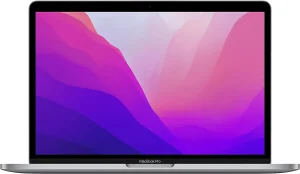
| Specification | Description |
| CPU | Next-generation 8-core CPU |
| GPU | 10-core GPU |
| Memory | Up to 24GB of unified memory |
| Battery Life | Up to 20 hours |
| Display | 13.3-inch Retina display, 500 nits brightness |
| Connectivity | Two Thunderbolt ports |
As a computer engineering enthusiast, I have extensively tested the Apple MacBook Pro, and it has truly impressed me with its exceptional performance and sleek design. This laptop is a portable powerhouse that allows me to accomplish more in less time, making it the perfect choice for professionals in the field.
The next-generation 8-core CPU and 10-core GPU deliver supercharged performance, enabling me to tackle CPU- and GPU-intensive tasks with ease. With up to 24GB of unified memory, I never have to worry about running out of memory, even when working on complex projects.
One of the standout features of the MacBook Pro is its impressive battery life. With up to 20 hours of usage on a single charge, I can work all day and even into the night without needing to plug in. This level of power efficiency is made possible by the Apple M2 chip, which ensures sustained performance and allows me to push the limits of my work without any slowdowns.
The 13.3-inch Retina display with 500 nits of brightness and P3 wide color provides a brilliant visual experience. Images are vibrant and detailed, making it a pleasure to work with intricate designs and code. The HD camera and studio-quality mics ensure that I look sharp and sound great during video conferences or online meetings.
Connectivity is a breeze with two Thunderbolt ports, allowing me to connect and power high-speed accessories effortlessly. The seamless integration with other Apple devices makes it easy to transfer files and work seamlessly across my ecosystem of Apple products.
Pros:
- Supercharged performance for CPU- and GPU-intensive tasks
- Impressive battery life for all-day productivity
- Stunning Retina display for vibrant visuals
- High-quality camera and microphone for professional communication
- Versatile connectivity options
- Seamless integration with other Apple devices
Cons:
- A limited number of Thunderbolt ports
- May have a higher price point compared to some competitors
A Comprehensive Buying Guide for the Best Laptop for Computer Engineering
Choosing the right laptop for computer engineering can be a daunting task, given the plethora of options available in the market. As an expert in the field, I understand the importance of finding a laptop that meets your specific needs and enhances your productivity. To help you make an informed decision, here are six essential factors to consider when choosing the best laptop for computer engineering:
- Performance: Computer engineering tasks often require substantial processing power. Look for a laptop with a high-performance CPU and GPU. Consider models with at least a quad-core processor and a dedicated graphics card for seamless multitasking and smooth rendering of complex designs.
- Memory and Storage: A sufficient amount of RAM is crucial for running resource-intensive software. Aim for a laptop with at least 8GB or more of RAM. Additionally, opt for a laptop with ample storage space, such as a Solid State Drive (SSD) with a capacity of 256GB or higher, to store your projects and software.
- Display: The display is vital for computer engineering work, as it directly impacts your visual experience. Look for a laptop with a high-resolution display, preferably Full HD or higher, to ensure crisp and detailed visuals. Additionally, consider a laptop with a larger screen size, such as 15 inches, for better productivity.
- Battery Life: As a computer engineering professional, you may find yourself working on the go or in locations where power outlets are not readily available. Hence, choose a laptop with a long battery life, ideally over 8 hours, to ensure uninterrupted work sessions.
- Connectivity and Ports: Computer engineering often involves connecting various peripherals and external devices. Ensure that the laptop you choose has an adequate number of USB ports, HDMI or DisplayPort for external displays, and an Ethernet port for wired internet connections.
- Durability and Portability: Since you may be carrying your laptop to different locations, it’s essential to consider its durability and portability. Look for laptops with sturdy build quality, lightweight design, and a compact form factor that fits easily into your bag.
FAQs
1. What is the ideal processor for a laptop used in computer engineering?
For computer engineering tasks, it is recommended to choose a laptop with a high-performance processor, such as an Intel Core i7 or AMD Ryzen 7. These processors offer excellent multi-threading capabilities and can handle resource-intensive software with ease.
2. How much RAM is sufficient for a laptop used in computer engineering?
To ensure smooth multitasking and efficient performance, it is advisable to go for a laptop with at least 8GB of RAM. However, if you work with demanding software or large datasets, opting for 16GB or even 32GB of RAM can significantly enhance your productivity.
3. What type of storage should I prioritize for computer engineering tasks?
It is recommended to choose a laptop with a Solid State Drive (SSD) as the primary storage option. SSDs offer faster data access speeds compared to traditional Hard Disk Drives (HDD), resulting in quicker boot times and faster file transfers.
4. Is a dedicated graphics card necessary for a laptop used in computer engineering?
While a dedicated graphics card is not a mandatory requirement for computer engineering tasks, it can be beneficial if you work with graphics-intensive software or engage in tasks like 3D modeling or video editing. A laptop with a dedicated GPU, such as an NVIDIA GeForce or AMD Radeon, can provide smoother rendering and improved performance in such scenarios.
5. Do I need a high-resolution display for computer engineering work?
Having a high-resolution display, preferably Full HD (1920×1080) or higher, can greatly enhance your visual experience when working on intricate designs or analyzing complex data. A sharper and more detailed display allows for better clarity and precision, especially when dealing with CAD software or programming IDEs.
Conclusion
Finding the best laptop for computer engineering is a crucial decision that can significantly impact your productivity and overall work experience. By considering factors such as performance, memory and storage, display, battery life, connectivity, durability, and portability, you can narrow down your options and choose a laptop that aligns with your specific needs.
Whether you’re a software developer, hardware engineer, or involved in data analysis, selecting a laptop that offers powerful processing capabilities, ample memory and storage, a high-resolution display, and long battery life will undoubtedly enhance your ability to tackle complex tasks efficiently.